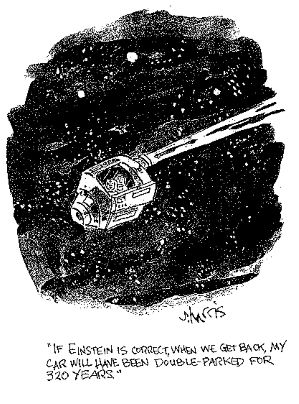Astronomy 162: Professor Barbara Ryden
The theory of Special Relativity, published by Einstein in 1905 (when he was 26 years old), describes how objects behave when they have a constant velocity. Ten years later, in 1915, Einstein published his theory of General Relativity, which describes how objects move when they are accelerated by gravity. (General Relativity is the subject of tomorrow's lecture; today we'll stick to the simpler case of Special Relativity.)
A concise sentence -- but what does it mean? Let's start
by examining what is mean by ``relative speed''.
A professor paces across a lecture platform.
Her speed relative to platform=
1 meter/second
Her speed relative to center of Earth=
360 meters/second
Her speed relative to center of Sun=
30,000 meters/second
Her speed relative to center of Galaxy=
220,000 meters/second
Which of the above speeds is the ``correct'' speed? They are all correct. When you state the speed of a material object, like a professor or a star, you are stating the speed relative to some other object. For massive objects, all speeds are relative.
To summarize the situation:
Speed of car relative to bystander = v = 30 meters/second
Speed of bullet relative to car = u = 250 meters/second
To find the speed of the bullet relative to the bystander,
just add the speeds together:
Speed of bullet relative to bystander = v + u = 280 meters/second.
The question ``What is the speed of the bullet?'' doesn't have a single answer. The speed of the bullet relative to the car is 250 meters/second. The speed of the bullet relative to the bystander is 280 meters/second. For that matter, the speed of the bullet relative to the center of the galaxy is 220,000 meters/second.
As an example of the absolute nature of the speed of light, consider the same criminal roaring down High Street in his getaway car. Relative to a bystander, the car has the same speed v = 30 meters/second. Now, however, the criminal draws a laser gun. A laser produces electromagnetic radiation, so relative to the car, the laser beam will travel at the speed of light: c = 300,000,000 meters/second.
To summarize the new situation:
Speed of car relative to bystander = v = 30 meters/second
Speed of light beam relative to car = c = 300,000,000 meters/second
What is the speed of the light beam relative to the bystander? A classical physicist, like Galileo or Newton, would say the speed is v+c = 300,000,030 meters/second. This, however, is WRONG. The correct answer, given by Einstein, is that the speed of the light beam relative to the bystander is c = 300,000,000.
The speed of light is absolute; that means it is the same seen by any observer, no matter how fast the observer is moving relative to the light source. THE OBSERVED SPEED OF LIGHT IN A VACUUM IS ALWAYS 299,792.459 KILOMETERS PER SECOND. (Parenthetical comments: it is necessary to add the qualification ``in a vacuum'' since interactions with matter can slow down a light beam. The exact value of the speed of light is usually rounded off to 300,000 km/sec for practical purposes. The speed of light is the speed of all electromagnetic radiation, from radio to gamma-rays.)
The fact that the speed of light is constant has been experimentally
verified, first by a pair of physicists in Cleveland in 1887.
The fact that the speed of light is absolute, while all other
speeds are relative, has some bizarre consequences. Suppose
I hand you a light bulb, and send you away from Earth with
a speed equal to 99% the speed of light. You say:
``The light bulb is stationary. The light
from the bulb is moving at a speed c.''
On the other hand, I say:
``The light bulb is moving at a speed 0.99c.
The light from the bulb is moving at a speed c.''
Two observers are moving at a speed 0.99c relative to each other. Each observer, using his own yardstick and clock, measures the speed of a particular beam of light to be the same. The only way the two observers to observe the same speed for the beam of light, Einstein concluded, is for odd things to be happening to the yardsticks and clocks with which they measure the speed of light.
Whose clock is correct? Both are correct. THERE IS NO SUCH THING AS ABSOLUTE TIME. The rate at which time flows is different for different observers.
Whose yardstick is correct? Both are correct. THERE IS NO SUCH THING AS ABSOLUTE SPACE. The distance between two points is different for different observers.
Suppose you accelerate an object by applying a constant force to it. As the speed of the object approaches the speed of light,
E = m c2
Where E is energy, m is mass, and c is the speed of light. Since the speed of light is large, a small amount of mass can be converted to a large amount of energy. One kilogram of matter is equivalent to 1017 joules, or 25 billion kilowatt-hours.

Updated: 2003 Feb 10
Copyright © 2003, Barbara Ryden